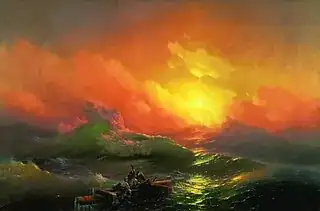No, there isn't any pattern to the waves. In fact, the waves are defined as "with random periods/frequencies", as you can see in this paper of modeling of sea waves and sea states, this is mainly due to how the waves are generated due action of wind, also as is described here, there, this webpage (more easy to understand), another page or in the extend bibliography, or this other bibliography list.
So we can cite the following: (My additions in bold):
Wind energy is imparted to the sea surface through friction and pressure, causing waves. (impossible for wind to "select waves" to give more energy) As the wind gains strength, the surface develops gradually from flat and smooth through growing levels of roughness. First, ripples form, then larger waves, called chop. The waves continue to build, their maximum size depending on three factors: wind speed, wind duration, and the area over which the wind is blowing, called the fetch. When ocean waves are as large as they can get under the current conditions of wind speed and size of fetch, the sea surface is said to be “fully developed.”
In the fetch, many different groups of waves of varying wavelength are generated and interfere (noted in the literature as sea state). As they disperse away from the fetch, the waves become more regularly sized and spaced (known as swell state). This is because the speed of a wave in open water is closely related to its wavelength. The different groups of waves move at different speeds and so are naturally sorted by wavelength.
— Oceana.org
Even when it is possible for two wave trains (generated by two diferent storms or conditions) to converge (as the largest, fastest-moving waves at the fore of the second train can "catch", the smaller, slower-moving ones behind of the first train) or the sorting of wave frequencies as described above, generate waves coupling that can be interpreted as this "ninth wave" this effect is accidental due the difficulty of measuring wave height with the naked eye, the variability of amplitude of the waves and phasing of the waves ratios and due the fact the most waves have periods between 8 and 26 seconds and it is extremely hard get in the sea periods ratios of 9 to 10 to generate this "ninth wave."
